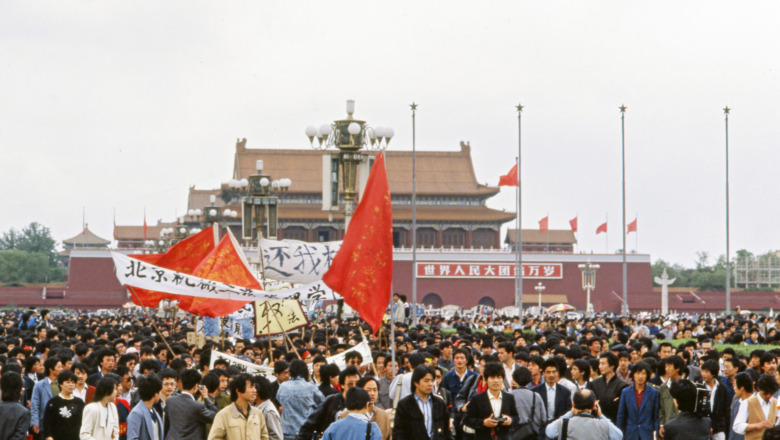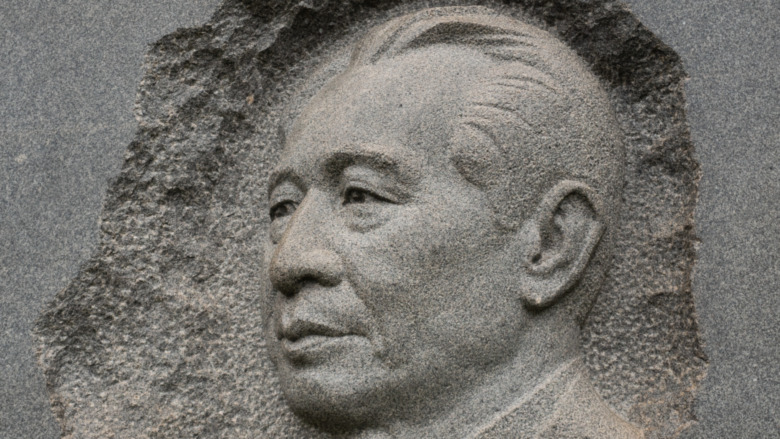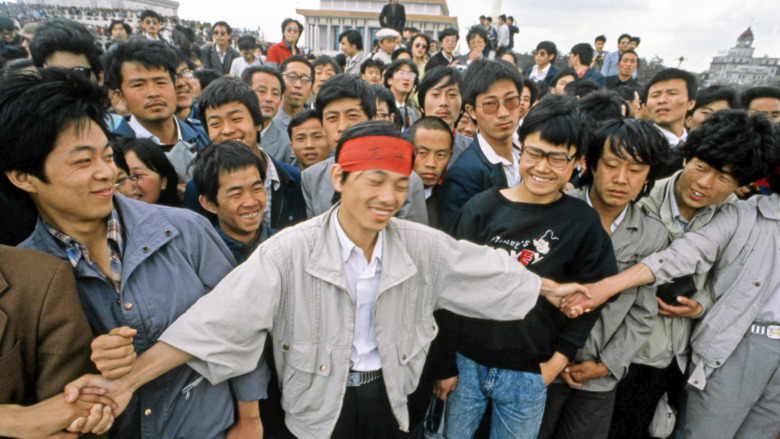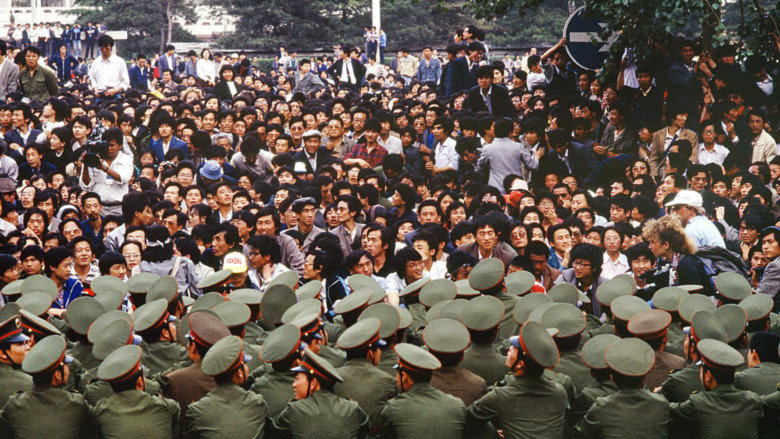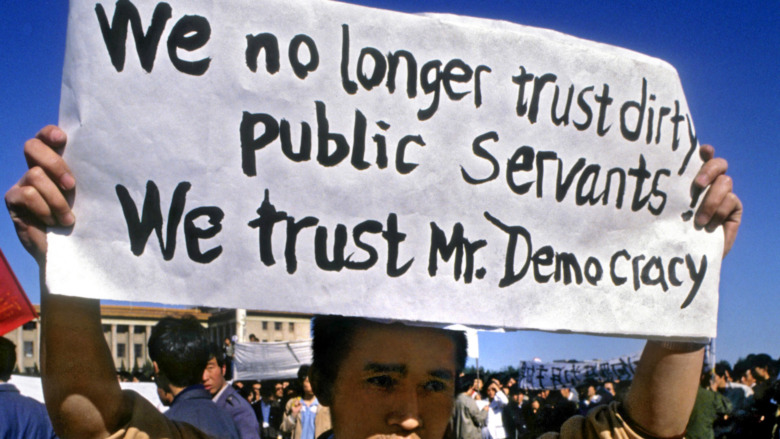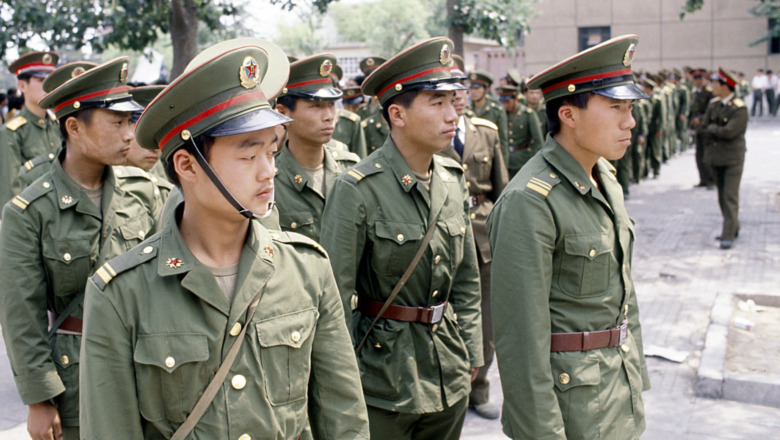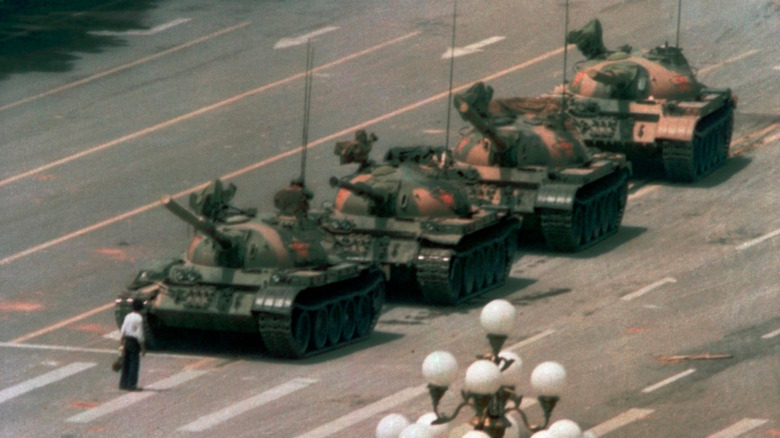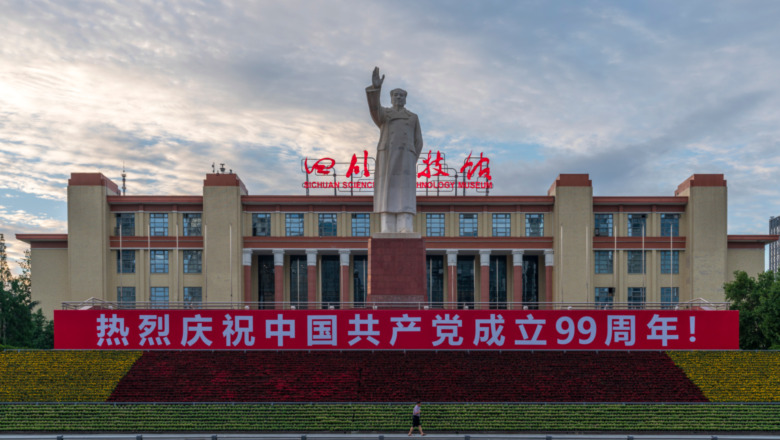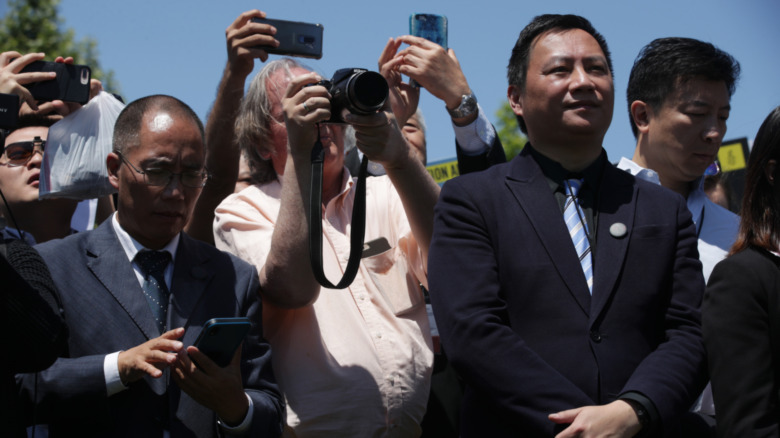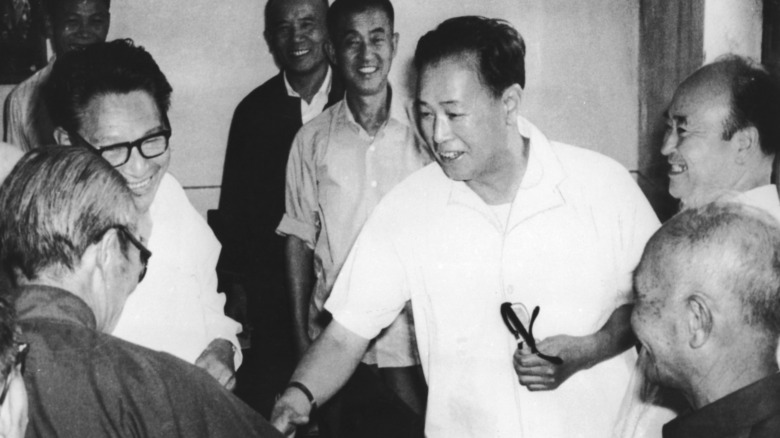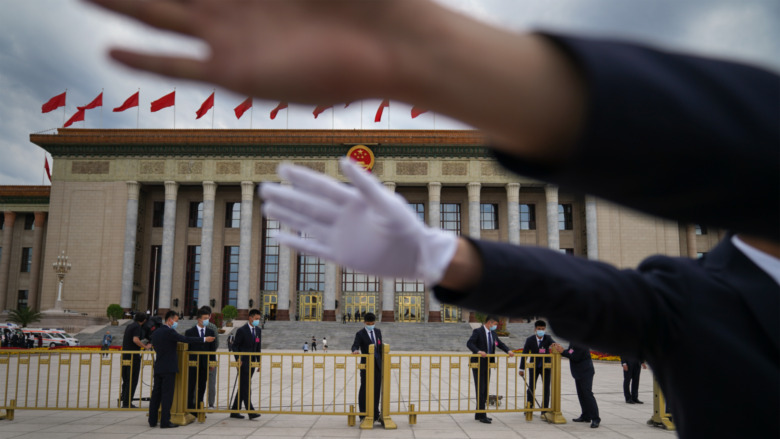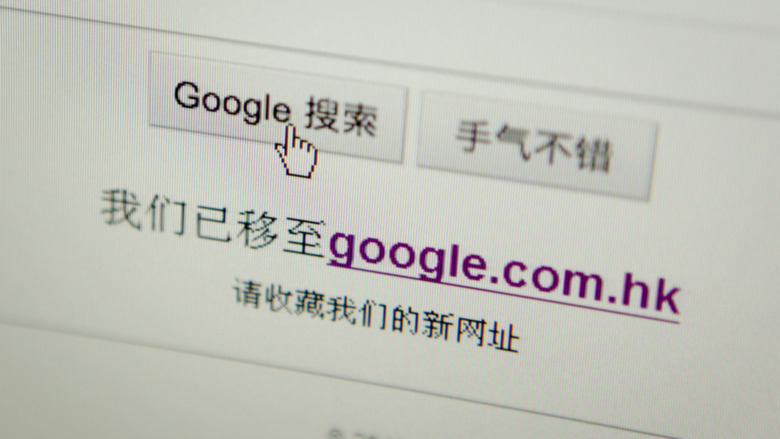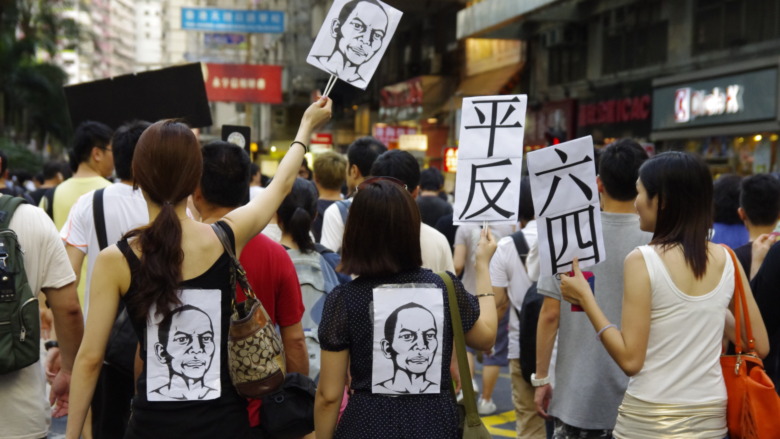The Most Disturbing Stories Surrounding The Tiananmen Square Protests
When most people think of Tiananmen Square they think of the iconic "Tank Man" image of a young man, most likely a student, standing in front of a tank blocking it from moving forward. It's a powerful image demonstrating the courage of the students who stood up in protest in 1989 to the Chinese government and military. But what it doesn't show are the many months leading up to that image — months of the students occupying and camping out in the square and demanding the government become more liberal. It does not show how the protests progressed into a bloody battle where everyday civilians of all ages and backgrounds sided with the students and together risked their lives to protect their cause.
The events at Tiananmen Square were a turning point in the Chinese government. Maoism turned China from imperialism, but then Mao Zedong was almost a king of sorts demanding loyalty. Those in government who were not loyal to him were ousted. After Zedong's death, the state's power was spread out more evenly amongst its leaders, but within that leadership came a divide — those who still wanted to control its people and those who wanted to listen to them. The student protests in Beijing and all over the country tested that divide. It was the moment in Chinese history when a door briefly opened to a more a liberal democracy but was ultimately slammed shut.
Death of Hu Yaobang
Hu Yaobang was born in 1915 and joined the Communist Party when he was only 14 years old. He participated in the Long March in the '30s and the Civil War in the '40s — both major events in which Communists fought against the Nationalist party and eventually won. China has been a predominantly communist country ever since. Within the party there were divisions between those who were more liberal and those more conservative. In other words, those who were more loyal to Mao Zedong, the party's leader, and those who were not. According to The Atlantic, Hu Dehua, Yaobang's son, quoted his father as saying, "Everything we do should be for the people, not for Mao."
Due to his outlook on Zedong, Yaobang was removed from the party during the Cultural Revolution in 1966. After Zedong's death in 1976, Hu Yaobang was allowed to reenter politics where he was eventually named the general secretary of the Communist Party. In 1986, students began to protest and voice their desire for a more liberal China. Yaobang believed the government should work with the students, and for this opinion he had to once again leave politics. The more conservative branch of the party equated "liberal" with "western" ideas and did not want China westernized. Two years after Yaobang stepped down, he died of a heart attack on April 15. According to The Washington Post, "When Hu died at the age of 74, more than 100,000 students took to the streets of Beijing to mourn him and called for a more transparent system and an end to corruption ..."
Students declare a hunger strike
Students taking to a public square to mourn an admired politician in China was not uncommon, but this time the students never left. They continued to protest at Tiananmen Square from the time of Hu Yaobang's death until May 13, when they declared a hunger strike and set up camp. The Communist Party was divided by those who wanted to listen to the students and those who saw them as a menace. According The Washington Post article from 1989, "More than 1,000 university students began a hunger strike in the center of Beijing tonight, pressing their demand for a dialogue with the government less than 48 hours before Soviet President Mikhail Gorbachev's arrival here." The fact that it intersected with Gorbachev's visit gave the protests national attention.
Tiananmen Square became a disaster, overrun with bodies and litter. Students were fainting from hunger and unable to negotiate with the government due to lack of concentration. According to a 1989 article in The New York Times, the students' creed was, ”Not before my aims are met do I eat again.” One such student, 21-year-old Xie Wanjun, was hospitalized twice. But once he was feeling better he rejoined the efforts despite pleas from his family to stop.
Government declared martial law on civilians
Around the time of the hunger strike, according to The Atlantic, "The crowd around the Square peaked at an astonishing 1 million people." After Mikhail Gorbachev's visit, the government was ready to take action. Zhao Ziyang took the place of Hu Yaobang as general secretary of the Communist Party and as the voice of sympathy for the students within the government. According to BBC, "Zhao went to Tiananmen Square in 1989, knowing that Party hardliners were gaining the upper hand, and implored the students to leave; to save themselves and their future lives; to negotiate with the Party."
Behind the scenes, Deng Xiaoping, chairman of the Central Advisory Committee, decided to suppress Ziyang and declared martial law to rid Tiananmen Square of its protesters. Most of the public sided with the protesters, as did some of the military. According to The New York Times, one such general refused to take action against the students. Gen. Xu Qinxian believed that the use of force was unnecessary and instead petitioned for negotiation. For this stance, Qinxian was arrested and spent four years in prison.
Bloody battle
Although the government declared martial law in May, it took until the night of June 3 to reach the square. Citizens living nearby blocked the military from getting through. Finally, according to The New York Times, soldiers were given the orders to "reach Tiananmen or die.” At Muxidi station, people continued to protect the students, fighting the military with "bricks and bottles." Angered and frustrated with their inability to break through, the army opened fire. According to historian Yang Jisheng, who visited the site the next day, "Everywhere you looked there were bullet holes." This confrontation had the highest death toll of the night, and the soldiers had not yet reached the square. No one knows the true death toll, as the Chinese government maintains that it was 300, but other counts are as high as 1,000.
In a PBS interview with Timothy Brook, a professor of Chinese history, he stated that, it took nearly three hours for the army to reach Tiananmen Square from Muxidi Station at "about 1:30 a.m." The people of Beijing kept placing blockades in their way. They never gave up, even after the bullets started flying.
Standoff on the square
The Chinese Government had made the point that no one was actually killed in the square, disregarding the fact they killed as many as 2,000-3,000 civilians on the way. According to June Fourth: The Tiananmen Protests and Beijing Massacre of 1989, once the military made it to Tiananmen, "some people left the square to fight back against or witness the army's attack. Many more slipped away to find safety. Those who decided to stay in the square to await the army's arrival huddled near the Monument to the People's Heroes." The students that remained were getting news of the slaughter and wanted to fight back.
According to "The Last Scene of the Tiananmen Incident," by Wu Renhua, a Chinese historiographer that was in China at the time of the massacre, one student wanted a gun so they could shoot back at the military. Chai Ling, one of the student leaders, told a broadcaster, "All of you who have the ability to resist, pick up anything that can be resisted, go to the edge of the square, prepare to defend yourself, prepare to resist!"
Then the students had a change of heart. They chose to drop their weapons and sing as the military was closing in on them, with some 40,000-50,000 soldiers surrounding the square. Bullets flew into the air, intimidating the students to leave. One of the student leaders was chosen to negotiate a retreat with the military. The majority of students left by 4:30 a.m.
Days later the destruction continues
At about 6:20 a.m. on the morning of June 4, tanks moved down Chang'an Avenue. According to June Fourth: The Tiananmen Protests and Beijing Massacre of 1989, one tank "... smashed through a group of students heading back to their campuses after evacuating the square. Eleven students were killed ..." Tanks continued to occupy the square, although most of the unrest had ceased.
"Tank Man," a photo of a young man standing in front of a tank, has become the most iconic image of the Tiananmen Square massacres. It was taken June 5, when the standoff was over, but the military continued to kill passers-by. To this day, no one knows who the man was or what happened to him. The image demonstrated how blocking the military was what the people did for days and continued to do. According to Business Insider, "Chinese tanks continued to drive down Beijing's central boulevards in the days after the killings, firing sporadically at anyone who continued to block their path."
Deadly protests outside of Beijing
Chengdu, a city over a thousand miles from Beijing, had its own "Tiananmen Square." Students stood in solidarity in the city's center and had confrontations with authority that led to many deaths and injuries. The protests started on April 15, and on June 4, the police arrived. Protestors left peacefully until the news of what happened at Tiananmen reached them. According to Time, "Street fights erupted, and, over the course of June 4, June 5 and June 6, turned into riots." Just as with Tiananmen, the Chinese government stated a conservative number of casualties (eight deaths, 1,800 injuries) compared with the much larger eyewitness accounts (more than 300 deaths, 1,000 injured).
According to The Guardian, the collection The Tiananmen Papers reveals that, "Protests were reported in 341 Chinese cities between April and June 1989." As the people of China heard what happened at Tiananmen Square, they wanted to fight back. Eventually the government squelched all of their efforts. Overall, students wanted the government to have less control in their lives. In one city, students were not allowed to date until they were a junior in college and then had to officially register their relationships. In provinces all over the country, students stood in solidarity and faced death, imprisonment, and injuries for their causes.
Protestors arrested and exiled
According to CNN, "as many as 10,000 people were arrested during and after the protests." Ten days after the Tiananmen Square massacre, the government released a list of the 21 most wanted student activists who were in hiding. Many of them escaped to Hong Kong and flew to the United States. One student, Zhou Fengsuo, was reported by family members and served one year in prison. Due to international political pressure, China released 211 protestors in 1990. Other student leaders were given much longer sentences. Wang Youcai was given three years, released, but detained again in 1998 for trying to register a branch of the Chinese Democratic Party. He was sentenced to 11 years in prison and then released into exile to the U.S. in 2004.
Not only students were considered "most wanted." Lu Jinghua was a mother and worked near the square where she would talk to the student protestors. After learning about their cause, she helped them by bringing food and water. In an interview with Amnesty International, she said, "I volunteered to be a broadcaster because of my voice. I would stand in Tiananmen Square and share the latest news over the loudspeakers. At night I would sleep in a tent at the square." After seeing her name on a most wanted list, Jinhua escaped in the middle of the night on a small boat to Hong Kong. She later flew to New York and was not reunited with her daughter until 1994.
Political leaders ousted and arrested
Zhao Ziyang, the most senior government official to openly oppose use of force against the students, was ousted. According to The New York Times, "He was purged and placed under house arrest until his death in 2005." While imprisoned, he secretly wrote a memoir called Prisoner of the State: The Secret Journal of Premier Zhao Ziyang. After Ziyang's death, the Chinese government did not want to release his ashes. It was not until the 100th anniversary of Ziyang's birth, in 2019, that the government allowed his family to conduct a small ceremony — with tight security.
Bao Tong, top aide to Ziyang, was sentenced to seven years in prison for siding with his superior. After his release, the government continued to harass him. According to Time, "Now he lives under virtual house arrest, his every move observed, every visitor screened by a handful of guards, every conversation presumably monitored." Despite the close eye the party has on him, he has spoken out against the problems with the party and its authoritarian ideals.
Journalists arrested and expelled
Since the hunger strike began while Mikhail Gorbachev was visiting, Beijing was full of foreign press covering the event. As things progressed at Tiananmen Square, many journalists stayed to report on the protests. After June 4, foreign correspondents were asked to leave. According to Voice of America, one of their journalists, Al Pessin, was asked to go to a government office, where a man read a statement to him. Pessin said, "He accused me of 'illegal news gathering' and 'fomenting counterrevolutionary rebellion.' He ordered me to leave China within 72 hours."
Gao Yu was a Chinese journalist who was arrested after the Tiananmen Square protests. According to UNESCO, she was released after 14 months due to health problems. She was again imprisoned in 1993 for leaking state secrets and given a six-year sentence. And as recently as 2014, she was imprisoned again for "leaking state secrets." According to a 2014 article in The Guardian, "The detention of the outspoken 70-year-old journalist was just one of several detentions of government critics over the previous days ahead of the politically sensitive 4 June anniversary."
China's censorship of the event
The People's Daily is the largest newspaper in China and is run by the Chinese Communist Party (CCP). As soon as the protests began, the paper and the CCP started reframing the events. According to PBS, an April 26 editorial stated, "This is a well-planned plot ... to confuse the people and throw the country into turmoil. ... Its real aim is to reject the Chinese Communist Party and the socialist system at the most fundamental level." The students protested this wording — they wanted the government to admit that students were merely exercising a right to speech. The CCP used this reframing to explain why they attacked at Tiananmen. They claimed the students were trying to overthrow the government and were being influenced by the west. To this day, this narrative remains.
It is entirely possible for a young Chinese person to not even know what happened at Tiananmen Square. It is not talked about in school, or in public, nor can a trace of it be found on the internet because of the government's firewall. Leading up to the anniversary of June 4, the government is notorious for amping up security to block any recognition of the events. According to The Washington Post, "Three-quarters of China-based journalists said they were subject to interference while reporting the anniversary." The only place the Chinese people can get away with memorializing the event is in Hong Kong, which has held an event every year.
Dissidents suffering decades later
Li Wangyang was not a student but a worker fighting for trade unions who was arrested right after the Tiananmen protests. He was sentenced to 11 years in prison, many of which he spent in solitary confinement. Then he was sentenced 10 more years for "his demands for government help with health problems caused by beatings and mistreatment in prison," according to The Guardian. One year after his release from prison, he died by suicide. Family members and the community were suspicious of his death, and activists called for an investigation. According to the BBC, Wangyang was under 24-hour police watch for stating he would continue advocating for reforms.
As recently as 2019, filmmaker Deng Chuanbin was arrested for tweeting an image that alluded to Tiananmen Square. According to Hong Kong Free Press, "The arrest came hours after he posted a Twitter photo of a clear spirit with a label that read 'ba jiu,' a near homophone of '89,' above an illustration of the iconic 'tank man.'" Only 30 minutes after his tweet he was contacted by police. They came to his home and took all of his electronic devices, including his phone. A few years earlier in 2016, four men were arrested for the creation of that same bottle — Fu Hailu, Zhang Jinyong, Luo Fuyu, and Chen Bing.
